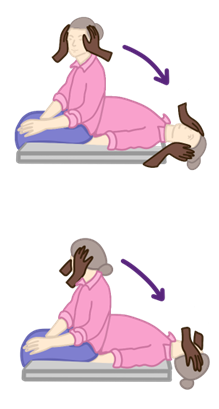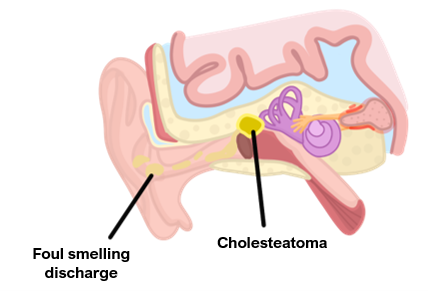Back to: Neurology
Ear Disorders
Disorders of the labyrinth
Benign Paroxysmal Positional Vertigo
This is a condition which causes movement-dependent vertigo.
It is seen more in elderly patients.
Symptoms come on suddenly when head position is altered.
It is not difficult to treat, but the symptoms do tend to recur after a few years.
Symptoms
Vertigo worsened by head movement, e.g., turning in bed
Each episode lasts less than 30 seconds and can make the patient feel sick/extremely dizzy

Key tests
A positive Dix-Hallpike manoeuvre – this reproduces vertigo and nystagmus is seen in the affected side
Management
Recovery is normally spontaneous but may take several weeks.
If persistent, the Epley manoeuvre allows particles in the semicircular canals to be relocated back into the utricle, so they do not stimulate the cupula triggering vertigo
Vestibular rehabilitation exercises can be used
If severe, patients can be given anti-emetics, e.g., prochlorperazine
Vestibular Neuronitis
This is an infection of the vestibular nerve that gives vertigo-like symptoms.
Since only the vestibular nerve is involved, there is no hearing impairment.
It is associated with a history of an URTI (cough, sore throat, fever).
Symptoms
Signs of recent URTI (cough, sore throat, fever)
Acute onset recurrent vertigo attacks (dizziness/nausea) lasting hours/days
Horizontal nystagmus but no hearing loss
Management
Usually self-limiting, but offer symptomatic relief
Cinnarizine/prochlorperazine can be used to alleviate dizziness and nausea/vomiting
Disorders of the ear
Presbycusis
This is a condition that gives sensorineural hearing loss, usually in the elderly and is caused by the natural ageing and degeneration of the auditory system over time.
There is no known cause, but it is related to genes, stress, noise and arteriosclerosis.
Symptoms
It affects high-frequency noises first, giving problems over a prolonged period
Speech becomes more difficult to understand (asking people to repeat themselves)
Hard to hear the TV (so patients increase the volume on TV and phone)
Problems understanding things in noisy situations
Key tests
Audiometry shows bilateral sensorineural hearing loss
Management
Hearing aids
Meniere’s Disease
A disorder which is due to an increase in fluid within the endolymph system of the inner ear, resulting in high pressure, leading to problems with hearing and balance.
For many patients, the symptoms do eventually resolve but they may develop some irreversible hearing loss.
Symptoms
Start with acute attacks in one ear, but then over time both ears become involved
Recurrent vertigo attacks with tinnitus/hearing loss lasting minutes to a few hours
Eventually the hearing loss and tinnitus may become constant
Feeling of aural fullness/pressure
Autonomic system symptoms (nystagmus, nausea, sweating, balance problems)
Key tests
Involves referral to ENT for audiometry and further tests
Management
To alleviate nausea/vomiting, medications including cyclizine or prochlorperazine
For prophylaxis, betahistine to reduce the frequency and severity of attacks
Cholesteatoma
This is a condition caused by a benign growth of squamous cells that exist in the middle ear behind the eardrum.
This can grow over time, leading to local destruction of nerves.
It can be a birth defect but is mostly caused by repeated middle ear infections.
It is mostly seen in teenagers, with higher risk if you are born with a cleft palate.

Symptoms
Conductive hearing loss
Foul smelling discharge from ear
Invasion symptoms – vertigo, facial nerve palsy
Key tests
Otoscopy shows keratinizing epithelium in upper part of ear drum
Management
ENT referral for assessment, may require surgical removal
Infections of the ear
Otitis Externa
This refers to inflammation of the external ear, which occurs usually due to a bacterial infection by Staphylococcus aureus.
It can also be due to dermatological conditions which affect the ear (eczema).
Symptoms
Pain localised to the external ear, but hearing loss/tinnitus is rare
Key tests
Otoscopy shows reddened lesions on the external ear
Management
Antibiotics. e.g., flucloxacillin (topical if localised, oral if severe/spreading)
If unresolved, consider contact dermatitis and take swab inside the ear canal
Complications - Malignant Otitis Externa
This is a complication which is usually caused by Pseudomonas aeruginosa.
It is seen more in immunosuppressed adults, typically in male diabetics.
The infection starts in the soft tissue, but it can then quickly spread to infect the bone lining the ear canal, eventually leading to osteomyelitis of the temporal bone.
It is very serious and leads to headaches, purulent discharge and severe pain.
Requires imaging (CT/MRI) to see the extent of infection and IV antibiotics.
Otitis Media
This is an infection of the middle ear, which is usually seen in children, often due to eustachian tube dysfunction.
It usually occurs with a history of an URTI (S. pnemoniae) causing a fever and cough.
Children can develop a glue ear (otitis media with effusion), leading to conductive hearing loss and secondary problems like speech and language delay.
Symptoms
Earache, fever, irritability, can cause tympanic membrane perforation
Management
1st line is 5–7 day course of amoxicillin (but strict antibiotic guidelines, only give if:)
Systemically unwell or high risk of complications
Younger than 2 years with bilateral otitis media
Otorrhea (discharge after ear drum perforation)
If symptoms do not improve after 3 days (use back-up prescription)
Complications - Glue Ear
This is a complication of untreated otitis media.
Fluid accumulates in the middle ear due to negative pressure difference leading to conductive hearing loss
Can lead to secondary problems like speech and language delay + balance problems in children
This may require surgical drainage of the fluid



